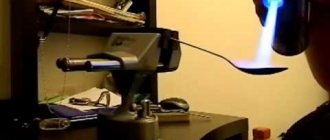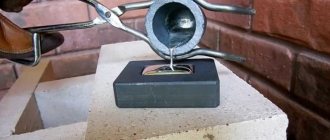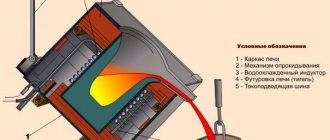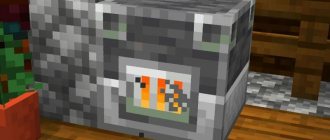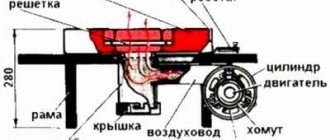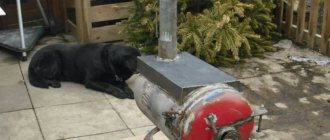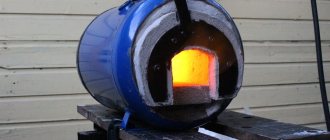Homemade furnace for melting aluminum at home, made by a craftsman with his own hands: detailed photo instructions for making a crucible furnace.
As you know, aluminum is often used by DIYers to make various homemade parts. The average melting point of aluminum is 650–660 ℃, so this metal can be melted at home, cast pigs and blanks for parts.
The manufacturing process of a crucible furnace for melting aluminum is presented in detail in the photo.
Purpose and classification
A metal smelting forge is a furnace that has been used in blacksmithing for many years. However, the small efficiency indicator determined that it was not used in the production of products from the alloy in question in industry. There is the following classification:
- By type of housing: open and closed. Open has a completely open top. The closed version has a closed top.
- At the installation location: stationary and personal forging.
Closed type forge
Open type forge
To remove gaseous combustion products, a special pipe is created if the work is carried out indoors. The open type does not have a pipe, since combustion products escape without being drained.
Inclined cylindrical kiln
Since the development of the inclined cylindrical kiln (Figure 1), more than 250 kiln units have already been delivered. The inclined cylindrical furnace is used for melting scrap, aluminum ingots and aluminum waste after casting.
This type of scrap has a relatively high specific density, which makes it easier to immerse the material in the bath after loading. Typically, there will be some residue left on the surface of the scrap in the form of mold lubricant, which will burn off when loaded. Therefore, it is important to prevent oxygen from contacting the metal to minimize scale deposits. Typical operations for this type of furnace include melting for various types of castings, in particular for the automotive industry, involving the recycling of their own scrap, and also as a secondary cycle melting furnace for the melting of ingots with different characteristics.
Figure 1 – Inclined cylindrical furnace
General operating principle
With your own hands, using scrap materials, you can create an effective system that will allow you to carry out forging work. There are a huge number of types of designs that you create with your own hands. A professional forge has the following elements:
- the table is made of fire-resistant material;
- there is a firebox with a grate;
- air chamber to improve fuel combustion efficiency;
- air drainage with supply air duct;
- valve for regulating air supply;
- tent;
- window for feeding workpieces;
- umbrella;
- chimney;
- crucible;
- hardening bath;
- gas-air chamber.
An example of a furnace design for aluminum smelting
The type of forging equipment in question can be called a classic forge, which is used in blacksmithing. It is quite difficult to create it with your own hands, but you can create a simpler design for melting aluminum.
Homemade induction furnace for melting metal with your own hands: diagram and video instructions
Metal smelting by induction is widely used in various industries: metallurgy, mechanical engineering, jewelry. A simple induction furnace for melting metal is not difficult to assemble at home; you can assemble it with your own hands, having diagrams and instructions.
Operating principle
Heating and melting of metals in induction furnaces occurs due to internal heating and changes in the crystal lattice of the metal when high-frequency eddy currents pass through them. This process is based on the phenomenon of resonance, in which eddy currents have a maximum value.
To cause the flow of eddy currents through the molten metal, it is placed in the zone of action of the electromagnetic field of the inductor - the coil. It can be in the shape of a spiral, figure eight or trefoil. The shape of the inductor depends on the size and shape of the heated workpiece.
The inductor coil is connected to an alternating current source. In industrial melting furnaces, industrial frequency currents of 50 Hz are used; for melting small volumes of metals in jewelry, high-frequency generators are used as they are more efficient.
Kinds
Eddy currents are closed along a circuit limited by the magnetic field of the inductor. Therefore, heating of the conductive elements is possible both inside the coil and on its outside.
- Therefore, induction furnaces come in two types:
- channel, in which the container for melting metals is channels located around the inductor, and a core is located inside it;
- crucible, they use a special container - a crucible made of heat-resistant material, usually removable.
The channel furnace is too large and is designed for industrial volumes of metal smelting. It is used in the smelting of cast iron, aluminum and other non-ferrous metals. The crucible furnace is quite compact; it is used by jewelers and radio amateurs; such a furnace can be assembled with your own hands and used at home.
Device
- A homemade furnace for melting metals has a fairly simple design and consists of three main blocks placed in a common body:
- high frequency alternating current generator;
- inductor - a spiral winding made of copper wire or tube, made by hand;
- crucible.
The crucible is placed in an inductor, the ends of the winding are connected to a current source. When current flows through the winding, an electromagnetic field with a variable vector appears around it. In a magnetic field, eddy currents arise, directed perpendicular to its vector and passing along a closed loop inside the winding.
They pass through the metal placed in the crucible, heating it to the melting point.
Advantages of an induction furnace:
- fast and uniform heating of the metal immediately after turning on the installation;
- direction of heating - only the metal is heated, and not the entire installation;
- high melting speed and melt homogeneity;
- there is no evaporation of metal alloying components;
- The installation is environmentally friendly and safe.
A welding inverter can be used as a generator for an induction furnace for melting metal. You can also assemble a generator using the diagrams below with your own hands.
Furnace for melting metal using a welding inverter
This design is simple and safe, since all inverters are equipped with internal overload protection. The entire assembly of the furnace in this case comes down to making an inductor with your own hands.
It is usually performed in the form of a spiral from a thin-walled copper tube with a diameter of 8-10 mm. It is bent according to a template of the required diameter, placing the turns at a distance of 5-8 mm.
The number of turns is from 7 to 12, depending on the diameter and characteristics of the inverter.
The total resistance of the inductor must be such as not to cause overcurrent in the inverter, otherwise it will be turned off by the internal protection.
The inductor can be fixed in a housing made of graphite or textolite and a crucible can be installed inside. You can simply place the inductor on a heat-resistant surface. The housing must not conduct current, otherwise eddy currents will pass through it and the power of the installation will decrease. For the same reason, it is not recommended to place foreign objects in the melting zone.
When operating from a welding inverter, its housing must be grounded! The outlet and wiring must be rated for the current drawn by the inverter.
Induction furnace with transistors: diagram
There are many different ways to assemble an induction heater yourself. A fairly simple and proven diagram of a furnace for melting metal is shown in the figure:
- To assemble the installation yourself, you will need the following parts and materials:
- two field-effect transistors type IRFZ44V;
- two UF4007 diodes (UF4001 can also be used);
- resistor 470 Ohm, 1 W (you can take two 0.5 W connected in series);
- film capacitors for 250 V: 3 pieces with a capacity of 1 μF; 4 pieces - 220 nF; 1 piece - 470 nF; 1 piece - 330 nF;
- copper winding wire in enamel insulation Ø1.2 mm;
- copper winding wire in enamel insulation Ø2 mm;
- two rings from inductors removed from the computer power supply.
DIY assembly sequence:
- Field effect transistors are installed on radiators. Since the circuit gets very hot during operation, the radiator must be large enough. You can install them on one radiator, but then you need to isolate the transistors from the metal using gaskets and washers made of rubber and plastic. The pinout of field-effect transistors is shown in the figure.
- It is necessary to make two chokes. To make them, copper wire with a diameter of 1.2 mm is wound around rings removed from the power supply of any computer. These rings are made of powdered ferromagnetic iron. It is necessary to wind from 7 to 15 turns of wire on them, trying to maintain the distance between the turns.
- The capacitors listed above are assembled into a battery with a total capacity of 4.7 μF. The connection of capacitors is parallel.
- The inductor winding is made of copper wire with a diameter of 2 mm. Wrap 7-8 turns of winding around a cylindrical object suitable for the diameter of the crucible, leaving the ends long enough to connect to the circuit.
- Connect the elements on the board in accordance with the diagram. A 12 V, 7.2 A/h battery is used as a power source. The current consumption in operating mode is about 10 A, the battery capacity in this case will last for about 40 minutes. If necessary, the furnace body is made from a heat-resistant material, for example, textolite. The power of the device can be changed by changing the number of turns of the inductor winding and their diameter.
During prolonged operation, the heater elements may overheat! You can use a fan to cool them.
Induction heater for metal melting: video
Induction furnace with lamps
You can assemble a more powerful induction furnace for melting metals with your own hands using electronic tubes. The device diagram is shown in the figure.
To generate high-frequency current, 4 beam lamps connected in parallel are used. A copper tube with a diameter of 10 mm is used as an inductor. The installation is equipped with a tuning capacitor to regulate power. The output frequency is 27.12 MHz.
To assemble the circuit you need:
- 4 vacuum tubes - tetrodes, you can use 6L6, 6P3 or G807;
- 4 chokes at 100...1000 µH;
- 4 capacitors at 0.01 µF;
- neon indicator lamp;
- trimmer capacitor.
Assembling the device yourself:
- An inductor is made from a copper tube by bending it into a spiral shape. The diameter of the turns is 8-15 cm, the distance between the turns is at least 5 mm. The ends are tinned for soldering to the circuit. The diameter of the inductor should be 10 mm larger than the diameter of the crucible placed inside.
- The inductor is placed in the housing. It can be made from a heat-resistant, non-conducting material, or from metal, providing thermal and electrical insulation from the circuit elements.
- Cascades of lamps are assembled according to a circuit with capacitors and chokes. The cascades are connected in parallel.
- Connect a neon indicator lamp - it will signal that the circuit is ready for operation. The lamp is brought out to the installation body.
- A variable-capacity tuning capacitor is included in the circuit; its handle is also connected to the housing.
Circuit cooling
Industrial smelting plants are equipped with a forced cooling system using water or antifreeze. Carrying out water cooling at home will require additional costs comparable in price to the cost of the metal melting installation itself.
Air cooling using a fan is possible if the fan is located far enough away. Otherwise, the metal winding and other elements of the fan will serve as an additional circuit for closing eddy currents, which will reduce the efficiency of the installation.
Elements of electronic and lamp circuits can also actively heat up. To cool them, heat sinks are provided.
Induction furnace for metal melting - where to buy and prices
- The main danger when working with a homemade installation is the risk of burns from the heated elements of the installation and molten metal.
- The lamp circuit includes high-voltage elements, so it must be placed in a closed housing to prevent accidental contact with the elements.
- The electromagnetic field can affect objects located outside the device body. Therefore, before work, it is better to wear clothes without metal elements and remove complex devices from the operating area: phones, digital cameras.
It is not recommended to use the device for people with implanted pacemakers!
A furnace for melting metals at home can also be used to quickly heat metal elements, for example, when tinning or forming them. The operating characteristics of the presented installations can be adjusted to a specific task by changing the parameters of the inductor and the output signal of the generating sets - this way you can achieve their maximum efficiency.
Brick construction
It is better to make it yourself using scrap materials. A mini forge of 6 bricks is suitable for obtaining various parts that are used to decorate metal objects, buckets or other parts. The creation process can be divided into the following stages:
- We create the body from fireclay bricks. Such a brick can withstand exposure to high temperatures for a long time. When choosing a brick, you should pay attention to the fact that it should not have damage or defects. This is because cracks will lead to heat loss.
- We create the grid grate shelves from scraps of steel pipes. Steel pipes should be of small diameter. Fusible material options cannot be used.
- The grate is made from steel strips, the thickness of which is 4-6 millimeters.
- We twist the grate at an angle with a screw.
- The fuel can be coal or coke.
- Ignition is usually carried out using a blowtorch. You can also use a gas burner.
- A window under the nozzle must be created when using a blowtorch. This is because the forge emits a lot of heat, which can cause the lamp tank to explode.
This type of design, which you can quickly create with your own hands, should be used exclusively outdoors, since there is no umbrella with a chimney. During smelting, a large amount of combustion products is released.
When considering the question of how to make a forge for melting aluminum, we note the possibility of creating portable versions. An example is a portable version of the track, which with additional elements are installed on a common base. The lining is represented by fireclay marl with fireclay sand. Another design element can be called an air supply system to the track, for which you can use, for example, a manual siren. It can run on coke or charcoal.
DIY forge for melting aluminum
You can make a replacement for a broken part or material to solder it yourself. After all, melting aluminum in small quantities is quite feasible even at home.
To do this, you will need to select or manufacture several simple devices, purchase raw materials and take care of personal protective equipment.
The process is associated with the possibility of getting burns from splashes of hot metal, and when molten high-purity aluminum comes out, there is also the danger of poisoning with toxic gases.
That is why it is recommended to manufacture products from high-quality materials, as well as work with large volumes of raw materials, only in industrial conditions.
Tools, materials, protective equipment
Before starting work, you need to prepare the necessary devices, such as:
- muffle furnace, blacksmith's forge or homemade hearth;
- crucible or other container made of refractory material (porcelain, quartz, steel, cast iron);
- crucible tongs;
- raw materials (wire or aluminum scrap);
- charcoal for the stove;
- gas burner or blowtorch;
- device for removing slag;
- casting mold;
- protective clothing, shoes, glasses or welder's mask, gloves;
- a bucket of water in case of fire.
The melting point of ultra-pure aluminum is 660°C, and that containing up to 1% impurities is even lower, about 643°C. Therefore, it is not advisable to heat the oven above 700°C.
In addition, when the metal overheats, the rate of formation of an oxide film on its surface increases significantly.
To reduce the yield of slag, reduce metal losses and improve its quality, it is recommended to use argon pressurization or add a special flux to the coal.
However, if you don’t have a respirator, it’s better to do without flux, since when it’s hot, it releases toxic substances, and the sodium fluoride it contains leads to rapid destruction of tooth enamel. In addition, especially pure metal is not required for household needs.
The muffle furnace protects the processed material from direct contact with fire.
Industrial products can be electrically or gas heated, with built-in protection for heating in a gas environment, with automated maintenance of a given temperature.
But if you need to melt just a little metal, you can use a simple hearth instead of expensive furnaces. To do this, a “well” is built from bricks, at the bottom of which coal is loaded and then set on fire.
When hot coals form, a container with aluminum is placed on top. Several kebab skewers can be used as a grill for it.
Sequence of work and safety measures
It is not recommended to use cans under the crucible: they burn out quickly and the hot metal can leak out.
For this purpose, you need to take an iron teapot, a copper coffee pot with the top part cut off, a homemade glass made of baked fireclay clay, and a part of a steel ladle.
The main thing is that the product has a thick bottom and, preferably, a spout for easy pouring of metal.
It must be made of a material with a melting point much higher than the melting point of aluminum.
The crucible is filled with raw materials quite tightly. For this purpose, the wire is cut into pieces, and the scrap metal is lightly compressed.
The crucible is then placed in a preheated furnace to melt the aluminum.
When transitioning into a liquid state, the volume of raw materials decreases significantly, so the metal must be gradually added to the crucible.
In this case, special care should be taken, since if even a small amount of moisture gets into the melt, it may splash out of the furnace.
If painted metal is used as scrap, care must be taken to protect the respiratory system, since toxic substances evaporate from the paint at high temperatures.
The metal begins to melt within a few seconds, but the smelting technology requires keeping it in the oven for at least 15 minutes so that the entire mass is heated evenly.
During the melting process, the crucible is shaken periodically, using special tongs and thick gloves as a safety measure. The composition can be mixed with steel wire.
When finished, it is a homogeneous shiny substance. For better fluidity, it is kept in the oven for a few more minutes.
Slag is removed from the surface immediately before pouring into molds. For this, a special device is used (outwardly it resembles a slotted spoon for removing foam from the broth).
With some skill, casting can be done without removing slag. If the container is not tilted strongly, only metal will spill out, and the scale will remain in the crucible.
Casting molds must be thoroughly dried, otherwise water vapor will tear them apart.
When using molten metal as solder, it is poured onto a preheated steel plate.
Tin cans and other scrap are recyclable! How to make a furnace for melting aluminum with your own hands
Aluminum alloys have a low melting point and good machinability of parts. And there is always a lot of aluminum scrap on the farm.
Therefore, aluminum is often melted at home to replace non-standard or small parts of mechanisms: a blank is cast, and then processed on a lathe. Sometimes souvenirs and small interior items are made from aluminum with their own hands.
ontakte
Odnoklassniki
Homemade furnaces for melting aluminum consist of a body - a metal cylinder (2) lined with refractory (fireclay with sand or concrete).
Inside the mine there is charcoal (8) , which serves as fuel. A crucible (3) is installed in it - a container in which the metal will be melted.
The crucible can be a thick tin can, a teapot or any stainless steel container.
In the lower part of the shaft (6) there is a hole for air injection (7) through the lattice base (4) , which allows you to maintain combustion and regulate the temperature in the furnace.
A hair dryer or a vacuum cleaner pipe is used as a blower. The damper (5) is necessary to remove excess air.
For furnaces with a capacity of several tens of kilograms, a lid (1) to quickly and evenly heat the metal. In small ovens you can do without it.
The furnace elements should not deform or melt when heated.
Therefore, the use of aluminum bodies, tubes and crucibles is unacceptable.
steel or cast iron to build the structure .
Reference. Natural gas or electricity are also used as fuel for aluminum smelting .
How to make a furnace for melting metal?
Creating a small unit that can melt several kilograms of aluminum scrap is not a difficult task. To lay out the stove in the garden you will need the following materials :
- red bricks - 20-25 pcs. ;
- tall tin can - 1 pc. ;
- grill grate - 1 pc.;
- dryer - 1 pc. ;
- a piece of pipe with a diameter suitable for the outlet of the hair dryer - 1 pc. ;
- roll of electrical tape;
- a piece of steel wire 30-50 cm long ;
- charcoal for ignition (the amount depends on how much aluminum needs to be melted).
The bricks will serve as both the body and the refractory coating of the furnace, and the tin can will act as a crucible.
Two holes are made in the upper part of the jar opposite each other, and a wire is threaded .
It will be possible to lift and remove the crucible with the melt from the furnace. The air will be supplied from the hairdryer turned on in cold air mode.
tape a piece of pipe to the outlet of the hair dryer with tape or tape - this will be the air duct.
Such a simple furnace design is convenient because no tools are actually required to create it; everything is done by hand.
Important! Do not use zinc-coated , as toxic zinc fumes will be released when melting aluminum.
Brick well installation plan
- Gives his all one row bricks in the form of a rectangular well.
The internal dimensions of the hole should be approximately length and width of one brick.On one side, two bricks are laid out to form a corridor for the air duct. The width of the corridor is equal to air supply tube
- A grate is installed on the laid out row . Instead of a grill grate, you can use any metal lid or plate with holes for air supply.
- A second row is laid on the grate , without any gap for the air duct.

